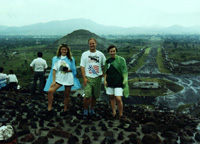 Photo.
Photo. The
Teotihuacan site in Mexico. As displayed in the photo, people stand on the Moon
Pyramid, with the Sun Pyramid in the background. © Travel Explorations.
The same ancient people who built the Teotihuacan complex, are also believed
to have built the recent found pyramid in Mexico City.
Archeologists found the huge 1,500-year-old pre-Hispanic pyramid in a working class
district of Mexico City after digging into a hill used every year
to depict the crucifixion of Christ.
Parts of the structure have been badly damaged as the hill has been used for
decades to stage re-enactments of the crucifixion of Christ during Holy Week.
The religious celebration is attended by as many as one million devotees.
The pyramid measured 150 metres (492 feet) on each of its four sides, amd it was 18-metres (59-foot)
tall. The pyramid was carved out on a natural hillside around 500 AD.
The unnamed pyramid has the same sized base as the giant Pyramid of the Moon
at the famous archeological site of Teotihuacan, an hour's drive northeast of
the capital, which is known as the "City of the Gods" and is Mexico's biggest
ancient city.
The site was abandoned in about 800 AD, when the Teotihuacan culture collapsed for
unknown reasons.
The site will not be fully explored because of its
religious significance, but it will certainly be a new important tourist attraction for Mexico anyway.
Read more about the amazing discoery at BBC`s website: BBC Discovery Pyramid
Mexico.
In May 2004 explorers ventured into a dark 2,000-year-old tunnel running
beneath the Pyramid of the Sun. It was above many thousands of tonnes of rock.
The tunnel was about 100 metres long.
Teotihuacan, the "City of the Gods", has kept its
secrets for more than two millennia. Some have been revealed the previous years,
but there are still secrets left waiting to be revealed for the world.
Stein Morten Lund, 11 April 2006
Additional information
Read more articles about Mexico, pyramids,
mysteries, ancient wonders and more on our website Travel Explorations
.





 Photo. The
Teotihuacan site in Mexico. As displayed in the photo, people stand on the Moon
Pyramid, with the Sun Pyramid in the background. © Travel Explorations.
Photo. The
Teotihuacan site in Mexico. As displayed in the photo, people stand on the Moon
Pyramid, with the Sun Pyramid in the background. © Travel Explorations.






